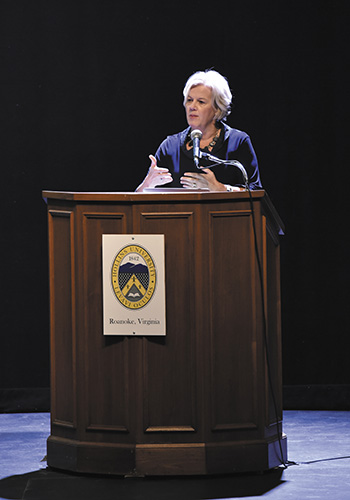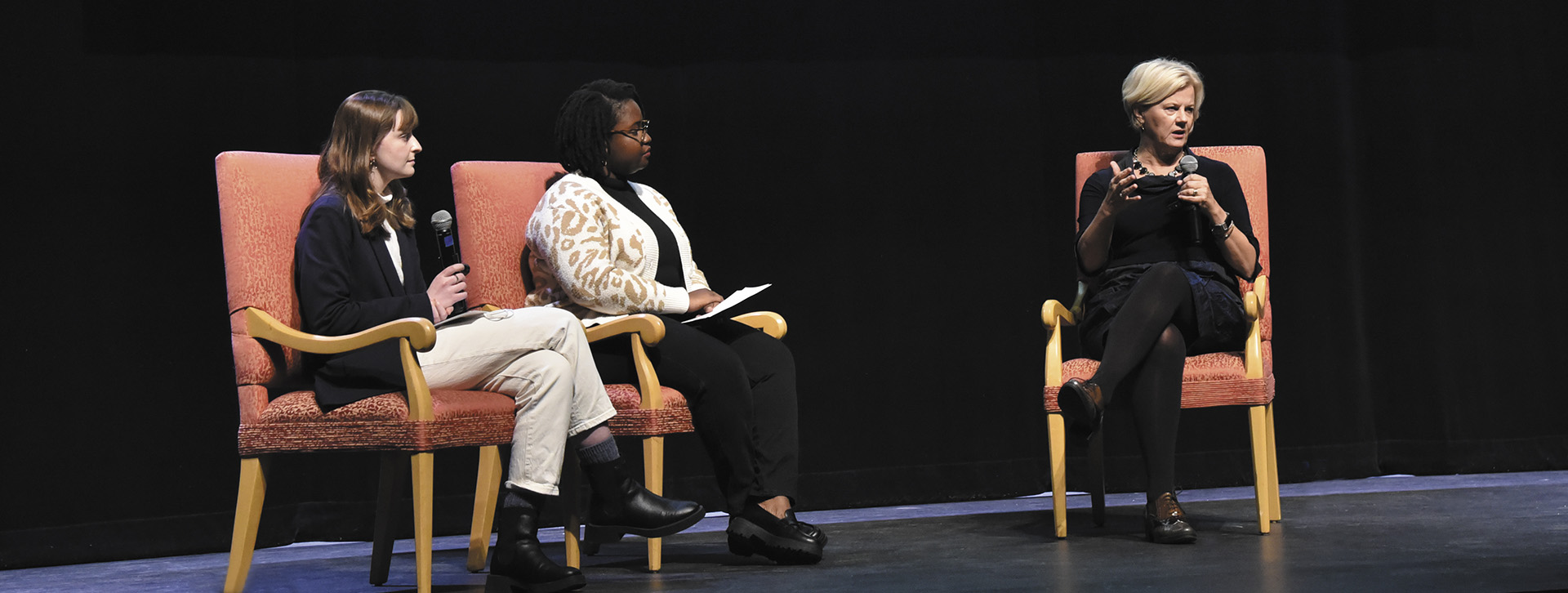Raising Lazarus and Coming Home: Beth Macy M.A. ’93 Returns to Hollins
by Marin Harrington M.F.A. ’23 and Julia Mouketo ’23
For Beth Macy M.A. ’93, there is nothing better than talking to strangers and telling them what she has witnessed, heard, and felt. She’s been at it since she was four years old. Indeed, Macy recalls that it was during that time that she ran away from her home on her tricycle with her beagle mutt, Tessie.
She was later found in the grocery store by a neighbor who brought her back to her mother, interrupting Macy’s chat with the butcher. When she was 10 years old, it was only normal that her first-ever job was that of a papergirl—and the first girl to do it in her neighborhood. Macy recalled that delivering the paper taught her to talk to all kinds of people. She explained that besides delivering the paper, she had to collect it from the printers on Fridays and Saturdays. This series of interactions with different people allowed her to understand that she had to negotiate, do math, and much more.
While her frantic childhood and first job drew the path of her career and life, Macy also believes that going to a university changed her life. Though fully on federal financial aid and some scholarships, Macy worked hard, sometimes taking multiple jobs to sustain herself. Experiencing life beyond her hometown of Urbana, Ohio, and escaping the small world she had known to that point, was very important to her, as was holding onto the life-changing idea that the world was a lot bigger than her small Ohio town. And so she did.
 She went on to become a talented journalist. Indeed, Macy worked with The Roanoke Times and contributed to publications such as The New York Times and The Atlantic—which she recalled not even knowing existed when she was in college.
She went on to become a talented journalist. Indeed, Macy worked with The Roanoke Times and contributed to publications such as The New York Times and The Atlantic—which she recalled not even knowing existed when she was in college.
She studied journalism at Bowling Green State University in Ohio and later got her M.A. in creative writing at Hollins University. She returned to Hollins last November as part of the Distinguished Speaker Series to talk about her newest book, Raising Lazarus: Hope, Justice, and the Future of America’s Overdose Crisis, and deliver a lecture stemming from topics explored in the book.
In her lecture, Macy discussed the activists, health care workers, addiction specialists, and patients who are the focus of Raising Lazarus, a follow-up to her New York Times bestselling 2018 book, Dopesick: Doctors, Dealers, and the Drug Company that Addicted America (which was also adapted into an Emmy award-winning Hulu miniseries). While Dopesick focused on the rise of the opioid crisis, Macy described Raising Lazarus as being about “people having that aha moment” with regard to successfully helping individuals who live with opioid use disorder (OUD).
“When I first started talking about Dopesick, I would tell people how we’ve lost 72,000 people in the last year and we know that’s an undercount. Plus, it doesn’t consider addiction-related suicide, hepatitis C, HIV, and endocarditis. Now I say we’ve lost 108,000—every one of them a tragedy,” Macy said. “I think what’s happening when we make the dope easier to access than the treatments is that people are falling through this giant chasm. They are dying because of this years-long divide between treating people like criminals and moral failures or treating them like people who have a medically treatable condition.”
A number of statistics strike Macy as emblematic of the problems—and solutions—facing those on the front lines of the opioid crisis: “We know addiction is a chronic relapsing disease. It takes the average person four to five treatment attempts over an average of eight years to get just one year of sobriety. We also know that we have a treatment gap of 87%, which means that in the past year, only 13% of folks have been able to get treatment for their addictions. That’s largely because we make the medicines for opioid use disorder—buprenorphine and methadone, the gold standards of care— almost impossible to get in the United States.

Beth Macy M.A. ’93 signed copies of her newest book and chatted with attendees in the Wyndham Robertson Library following her talk.
“The reason I thought this book was so important to write now is because of the opioid litigation settlement dollars about to come down. In fact, some of it is already landing in communities. Every dollar that we spend on treatment can save $12 or more on reduced criminal justice and health care costs,” Macy explained. “When I talked about Dopesick after it was published, I started to hear really innovative, exciting things that were happening and I decided I wasn’t done yet. I think this will be a way for people to have a guidebook on what to do with the opioid litigation money.”
In Macy’s purview, the most essential work being done right now is increasing patient access to medication-assisted treatment for OUD. “About 5% of folks with OUD were able to access buprenorphine in the past year, but a local couple, the Doctors Hartman, run an outpatient clinic for Carilion and they continue to increase their capacity to help more people,” she said. “I wrote a piece for The Atlantic in March 2020 about this addiction pioneer I had met named Nikki King. She started working as a mental health and addiction specialist at a rural hospital in Indiana, where the community had just voted that their number-one problem was the opioid epidemic. Judges and the cops are trying to come together and Nikki says, ‘Well, what are we doing now for people when they’re getting out of prison or jail? Their addiction hasn’t been treated in jail and they are 40 times more likely to overdose and die if they return to use, so it’s a really vulnerable moment.’
“When I talked about Dopesick after it was published, I started to hear really innovative, exciting things that were happening and I decided I wasn’t done yet.”
“Nikki designed a program working hand in hand with probation and the courts to bathe folks getting out of jail in services. When she met with the first group she asked them what their goals were, and one person said he wanted a second pair of pants; another person said he wanted to taste salmon for the first time. They were all food insecure; they all had spent their entire teenage years, 20s, and 30s cycling in and out of jail, so the program provided them services: nighttime intensive outpatient treatment so they could work during the day, help getting jobs, food security, and signing them up with Medicaid. They were able to get on their buprenorphine, and in 18 months they had zero overdose deaths. That’s astonishing.”
Macy is also full of suggestions for citizens of the Roanoke area who want to be involved in harm reduction movements. “I would suggest contacting the Virginia Harm Reduction Coalition, which is running mobile now. They now have an outreach worker in Southeast Roanoke and they’re doing amazing work. You can go pack Narcan kits, make donations, and use your voice as a citizen if you know judges or other members of law enforcement.
“A lot of people think I called the book Raising Lazarus because of the overdose antidote Narcan, which is part of harm reduction, but it’s really because it’s a story a harm reduction worker I know, Michelle, uses to get people who haven’t bothered to educate themselves about the opioid crisis to check their blind spots. She’ll say, ‘Jesus brought Lazarus back. He performed the miracle, but then he had the disciples roll the stone to bring Lazarus out. He had the disciples unbind Lazarus and remove his burial cloth.’ And what she says to groups that aren’t so sure they want to do this work is, ‘It’s messy, it’s stinky, you might get a little something on you, but only by getting close to the ground will you experience the miracle of raising Lazarus.’”

